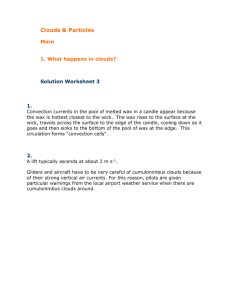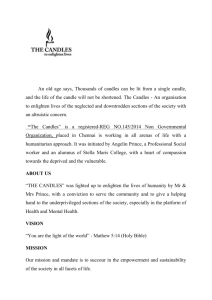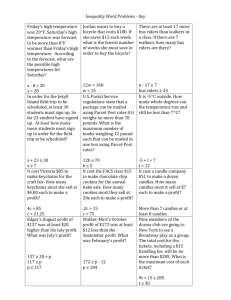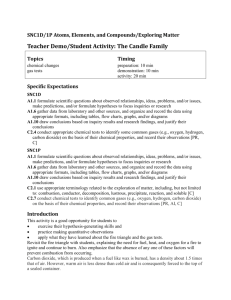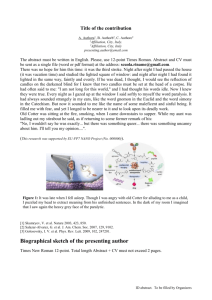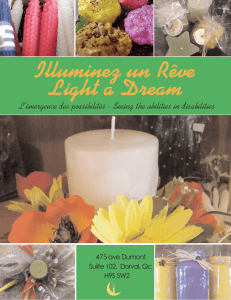SAMPLE INFORMATIVE SPEECH OUTLINE
advertisement
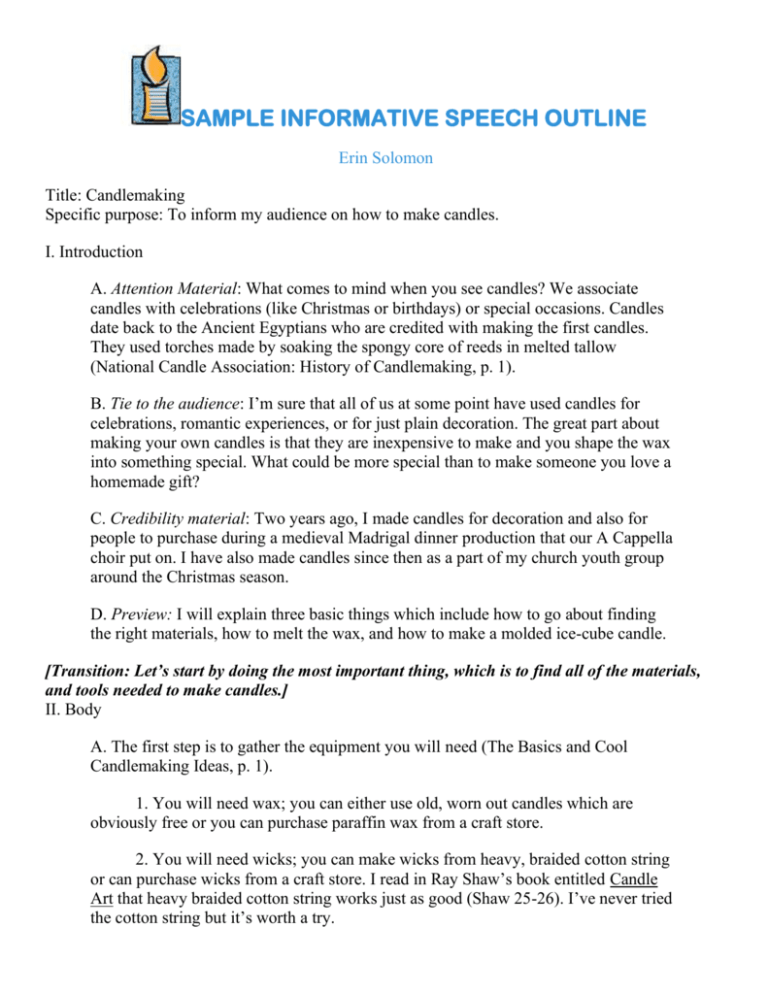
SAMPLE INFORMATIVE SPEECH OUTLINE Erin Solomon Title: Candlemaking Specific purpose: To inform my audience on how to make candles. I. Introduction A. Attention Material: What comes to mind when you see candles? We associate candles with celebrations (like Christmas or birthdays) or special occasions. Candles date back to the Ancient Egyptians who are credited with making the first candles. They used torches made by soaking the spongy core of reeds in melted tallow (National Candle Association: History of Candlemaking, p. 1). B. Tie to the audience: I’m sure that all of us at some point have used candles for celebrations, romantic experiences, or for just plain decoration. The great part about making your own candles is that they are inexpensive to make and you shape the wax into something special. What could be more special than to make someone you love a homemade gift? C. Credibility material: Two years ago, I made candles for decoration and also for people to purchase during a medieval Madrigal dinner production that our A Cappella choir put on. I have also made candles since then as a part of my church youth group around the Christmas season. D. Preview: I will explain three basic things which include how to go about finding the right materials, how to melt the wax, and how to make a molded ice-cube candle. [Transition: Let’s start by doing the most important thing, which is to find all of the materials, and tools needed to make candles.] II. Body A. The first step is to gather the equipment you will need (The Basics and Cool Candlemaking Ideas, p. 1). 1. You will need wax; you can either use old, worn out candles which are obviously free or you can purchase paraffin wax from a craft store. 2. You will need wicks; you can make wicks from heavy, braided cotton string or can purchase wicks from a craft store. I read in Ray Shaw’s book entitled Candle Art that heavy braided cotton string works just as good (Shaw 25-26). I’ve never tried the cotton string but it’s worth a try. 3. You need to set up a double boiler. a. You can use an actual double boiler b. You can make your own using a pan and a jar or coffee can. 4. You will need a mold if you are planning on making a molded candle. This can be anything; a milk carton, Dixie cups, tin can, paper towel tube, etc. 5. There are two optional ingredients. a. You can use crayons of the desired color wax or buy wax dye. b. You can purchase scented oil to make your candles smell wonderful. [Transition: Once you have all the material that you need, you can move on to melting the wax.] B. Your second step is to melt the wax (Pioneer Clubs: Trailblazer Handbook, p. 165). 1. Place wax in the double boiler or in a coffee can put in a pan of water. 2. Heat until the water boils. 3. Make sure to turn down the heat, and let the wax melt. Don’t let it boil. 4. Add wax dye, crayons, or scent (if desired) and stir. [Transition: Now that the wax is melted, you can let your creativity run wild and have fun making candles. You can make just about anything but I’m going to show you how to make a molded icecube candle. ] C. This is how you go about making a molded ice-cube candle (Pioneer Clubs: Trailblazer Handbook, p.166). 1. Cut off the top of a milk carton. 2. Place a candle the height of the carton in the center of the carton. This makes an excellent wick. 3. Break ice-cubes into chunks a. Finely crushed ice creates small holes.Large cubes create large openings. b.Fill the mold with crushed ice. c. Quickly pour hot wax into the carton while someone holds the candle straight. d. Pour off the excess water when the wax is completely hardened. [Transition to conclusion: Now that you know how to make an ice-cube candle, let’s go over what I showed you today.] III. Conclusion A. Final Review: So today I showed you how to do three basic things. 1. I showed you how to find the right materials. 2. I showed you how to correctly melt the wax. 3. I showed you how to make an ice-cube candle. The tricky part is keeping the wick in the center of the mold. B. Tie back to the audience: Today we use candles for almost any kind of occasion or celebration. Candles continue to grow in popularity and we see them just about everywhere. They are really inexpensive to make and a lot of fun! C. Concluding remarks: So when you try making candles on your own, use your imagination and be very creative. Your candle can be anything you like. Have a great time experimenting and having fun making your own candles to enjoy. Works Cited: The Basics and Cool Candlemaking Ideas. [Online] Available http://homepage.interaccess.com/~bmolo/basics.html . National Candle Association: History of Candlemaking. [Online] Available http://www.candles.org/history.htm Pioneer Clubs (1994). Pioneer Clubs: Trailblazer Handbook. Wheaton, IL: Published by Pioneer Clubs Shaw, R. (1973). Candle Art. New York: William Morrow & Company, Inc. RESULTS OF MY AUDIENCE SURVEY: (NOTE THAT THIS MAY BE DIFFERENT THAN THE QUESTIONS I ASKED THIS SEMESTER...BUT HERE SAMPLE YOU GIVE YOU AN IDEA OF HOW TO RESPOND...CHECK YOUR ASSIGNMENT FOR THE SPECIFIC QUESTIONS.) 1. My audience survey included one fixed-response question, one ranked question, and one open question. The fixed-response question was: Have you ever made your own candles? Yes or no. Twelve out of the seventeen students in the class responded no. So the average response was that they had not made their own candles before. 2. The ranked question was: On a scale of 1 to 10, how much do you know about the history of candlemaking and how it came about? (1 being very little knowledge and 10 being a great amount of knowledge). The entire class responded to this question with a 4 or below. The average was a 1 being that they had very little knowledge of the history of candlemaking. 3. The open question was: What do you think is the hardest part of making candles? I got a wide variety of responses. The most common response was dealing with the wick, such as "making wick stay in the middle." Other responses were patience and creativity. 4. I took this information and wrote my speech accordingly. Since the majority of the class had not made candles before, I included how to go about finding the right materials and how to melt the wax. Since there were a few students that had made candles before, I decided to show the class how to make a molded ice-cube candle which something many people probably haven’t made before. I found out through my survey that the class doesn’t know much about the history of candlemaking so I decided to include a quick fact about the first candles in my introduction. I also took into account that people thought that keeping the wick in the center is the hardest part about candlemaking. So I chose to show them how to make a molded ice-cube candle so I could show them how to keep the wick in the center. So I did take into consideration the responses that I received from the other students when I wrote my informative speech.

